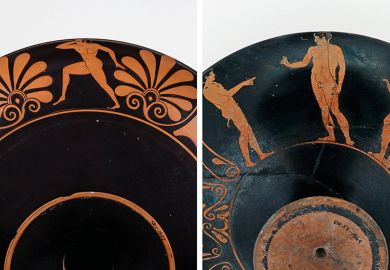“Stop it! I’ll scream./What are you doing?/It is wrong to take my clothes off!”
In the Latin comedy Pamphilus, the protagonist forces himself on an older woman, Galathea, who begs him several times to let her go. This sexually violent scene narrated by a female character might not seem the obvious text for medieval schoolboys to study; but as Majorie Curry Woods argues in this slim but scholarly volume, they would have not only studied it but also recited it aloud.
Woods’ thesis – that medieval schoolboys were given the opportunity to engage emotionally with classical texts and through them form empathetic connections with their characters – is supported by a sensitive reading of the teachers’ notes and marginal commentary to be found in the manuscripts of three texts. The Aeneid will be familiar to modern readers; the Ilias Latina and Statius’ Achilleid less so. Yet these short verse narratives – one a condensed Latinised version of the Iliad and the other a Bildungsroman about the great hero Achilles – were both used as set texts in the medieval classroom. Such texts were heavily annotated in the medieval manuscripts, with interlinear glosses providing grammatical notes and marginal notes ensuring comprehension of the narrative.
Taken together, the notes demonstrate the meticulous attention to detail of medieval teachers, where attention often focused on the emotions experienced by the characters. The adolescent St Augustine’s passionate engagement with the Aeneid, and particularly his wholehearted empathy with doomed Dido, is well known to scholars. Woods argues that this may not have been an exceptional experience, but rather that the classical curriculum of medieval schools, based around texts that provided opportunities to explore intense emotions at the same time as thrilling action, may have given boys the opportunity to “escape from the world outside” as well as developing their sense of empathy.
Woods nuances this reading of sensitive schoolboys by remembering the classroom context. While an individual boy might have felt for Galathea, she wonders whether “in a group setting, boys might have focused on comic potential”. Group dynamics might make the rape victim an object of derision, not a subject of empathy. Schoolboys might easily subvert the marginal instructions that tell the student to, for instance, recite a speech by Aeneas in the “Dignified Conversational Tone”. My own schoolroom experiences make me wonder about the kind of voice a student might have adopted, and how quickly he might have reduced his fellows to giggles.
I found this easier to translate into a medieval context because I know something about schools of the period. It is a shame that Woods provides little broader social context that could round out the details about both pupils and teachers in the medieval classroom. This book will be of vital interest to scholars of medieval education. Classicists interested in the medieval reception of classical texts will also find it fascinating, but may need to read it alongside a more general introduction to the medieval school to make clearer sense of its intelligent conclusions.
Rachel Moss is a lecturer in history at the University of Northampton.
Weeping for Dido: The Classics in the Medieval Classroom
By Marjorie Curry Woods
Princeton University Press
200pp, £30.00
ISBN 9780691170800
Published 26 February 2019
POSTSCRIPT:
Print headline: Lessons in Latin, love and empathy
Register to continue
Why register?
- Registration is free and only takes a moment
- Once registered, you can read 3 articles a month
- Sign up for our newsletter
Subscribe
Or subscribe for unlimited access to:
- Unlimited access to news, views, insights & reviews
- Digital editions
- Digital access to THE’s university and college rankings analysis
Already registered or a current subscriber? Login








